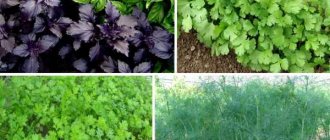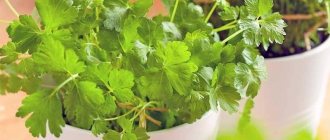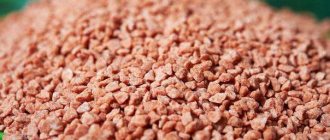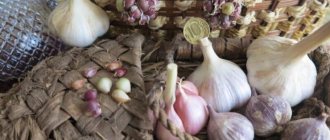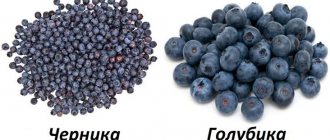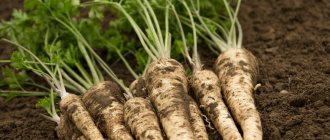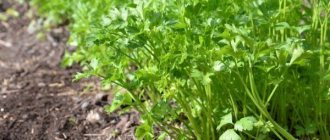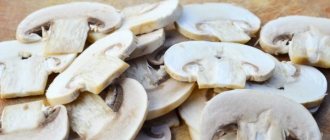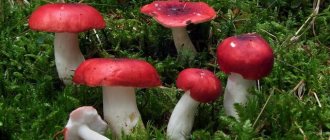Is this the same thing or not?
Cilantro or coriander are not the same thing as parsley. Differences between plants can be traced even at the stage of their growth in the garden bed:
- cilantro is an annual plant and produces seeds every year;
- parsley is a biennial plant that forms wedge-shaped roots in the 2nd year.
The latter spice grows in the form of small bushes, no more than 30 cm high. Over time, parsley stems can stretch up to 100 cm. Plants differ in the shape and size of the leaf blades, the length of the stems and the smell.
Attention! There is a variety of curly parsley that is not similar to cilantro. It has small, curly leaves.
Definition and brief botanical description
Coriander and parsley are herbs used in cooking and alternative medicine in fresh and dried form.
Parsley
Parsley belongs to the Umbelliferae family. The biennial plant has a straight stem that branches into several smaller cuttings with large maple-shaped leaves at the ends. The length of parsley reaches from 30 to 100 cm. The root system is branched. The flowering period occurs in June-July.
Coriander
The genus coriander belongs to the Apiaceae family. An annual herbaceous plant with straight, bare stems branching at the top. Their length ranges from 40 to 120 cm. Triangular leaves can be glossy. Spicy greens bloom in early summer.
Cilantro is usually called the green part of the plant, coriander is its seeds.
A little history with geography
Both spicy plants became known to mankind several thousand years ago. Cilantro was presented on the tables in the dishes of the ancient Romans, more than 5 thousand years ago, it was the Romans who spread the culture throughout the world. She was respected throughout the Mediterranean, as well as in the eastern countries of the Persian Gulf, Central Asia and China. And in Russia, the spicy “kishnets” (that’s how coriander was nicknamed) was mentioned for the first time in the 18th century.
Parsley is a native of the same Mediterranean, this unpretentious plant grew on the rocky soil of Greece (hence the name from the word “peter” - rock, stone), was known to the Egyptians and Romans, but was not used as food, but decorated funeral tables. Due to funeral superstitions, the seasoning plant was only used in Europe by the 9th century AD. At first the root was eaten, and gradually the foliage was also eaten. In Rus' it was called “pestrets” or “petrosilov grass”, it was used in rituals, it was considered healing, especially parsley juice.
Afterword
Cilantro is also called Chinese parsley, hamem, schlenra, chilantro. Each nation has its own “local” name for the plant, although they say that the Mediterranean countries became the birthplace of cilantro. In China, they believed that the seeds of a plant could give a person immortality, better than any philosopher's stones. In Ancient Egypt, the seeds were placed in the tombs of the pharaohs, and in the Middle Ages, cilantro was considered a powerful component of love potions.
However, there are many known products that have healing properties, which in “dark” times were credited with miraculous abilities bordering on mysticism.
In many countries (including Ancient Rome), fresh cilantro branches were used as a means to stimulate appetite and as an excellent “anti-hangover.” By the way, even now a fresh bunch of cilantro can replace cucumber pickle in the morning after heavy libations. Perhaps the domestic hostility to the plant is due to late “acquaintance”: it was first brought to Russia only at the beginning of the 19th century. Cilantro has not yet been able to displace dill and parsley, although it is in no way inferior to them in terms of its range of useful properties.
Characteristics of parsley and coriander
Fragrant parsley and tart coriander, which can be found on store shelves in winter and in garden beds in summer, have different chemical compositions and origins. To understand how one plant differs from another, consider their characteristics.
Characteristics of parsley
Curly parsley (Petroselinum crispum) is a herbaceous plant native to the rocky soils of southern Greece. The name “petroselinum” itself is translated from Greek as “growing on a stone.”
Botanical characteristics:
- family Umbelliferae, class Dicotyledons;
- growing season 2 years;
- plant height 30-100 cm;
- the root system is taprooted, the root has a spindle-shaped thickening;
- stem erect;
- leaves are twice pinnately dissected, triangular in shape, dark green with a shiny surface;
- the flowers are greenish-yellow, collected in inflorescences in complex umbels at the tops of the stems;
- fruits are oblong-ovoid;
- The flowering period is from June to July, the fruiting period is in August.
The shoots of the first year of the growing season produce a larger harvest of greenery, the shoots of the second year are more prolific in terms of seeds.
Chemical composition of seeds:
- essential oils (up to 7%) containing apiol, furocoumarin, bergapten and apiin;
- nutrients – fats (up to 22%), proteins, carbohydrates;
- vitamins A, E, C, groups B and H;
- mineral components - potassium, calcium, magnesium, sodium, phosphorus and iron.
Parsley seeds are used to obtain essential oil, and also as a raw material for the production of technical oil, in cooking - as a seasoning for baking bread. In medicine, shoots and seeds are used as components of diuretic preparations; a number of drugs used for flatulence, neuralgia and dysmenorrhea are obtained from them.
Chemical composition of fresh greens:
- nutrients - proteins, fats, carbohydrates;
- vitamins – A, E, K, C, H, group B;
- essential oil (up to 0.3%);
- biologically active substances – flavonoids and phytoncides;
- minerals - potassium, calcium, iron, magnesium, phosphorus, sodium, zinc, copper, manganese and selenium.
Fresh and dried greens are used in cooking as a seasoning for meat, fish dishes, soups and salads. Umbrellas and dried leaves are added to canned dishes.
Juice is obtained from fresh shoots, which is used in folk medicine as a prophylactic that improves the functions of the adrenal cortex and thyroid gland. In traditional medicine, dietary supplements and drugs that have a diuretic effect are made from parsley.
Various ways to grow greens at home
Installation for growing greens at home using the hydroponics method
Growing greens in pots
Growing greens in drainage channels
Growing onions in bottles
Comparative characteristics of parsley and coriander
The plants belong to the same Apiaceae family, but to different genera. The differences between cilantro and parsley are shown in the table.
| Distinctive feature | Parsley | Cilantro |
| Leaf Shape | Double pinnately dissected | Trifid, coarsely dissected and doubly pinnately divided |
| Smell | Pleasant, spicy | Unpleasant, pungent "bug" |
| Use during pregnancy | Forbidden | Allowed in limited quantities |
| Daily consumption rate | 50 g, exceeding the norm can lead to poisoning, hallucinations and convulsions | 105 g, exceeding the norm leads to sleep disturbances, weakened memory, and hormonal imbalances in women |
| Content of vitamins (except A, group B, E, K and C, which are contained in both plants) | Contains biotin - vitamin H | Contains niacin - vitamin PP, choline - B4 |
| Flower color | Greenish yellow | White or pink |
| Stems height | Up to 100 cm | Up to 70 cm |
| Plant lifespan | 2 years | 1 year |
In the photo you can see the difference in the appearance of these two herbaceous plants, but the most telling sign by which you can distinguish coriander and parsley is the smell. If a bunch of greens smells like bugs, you're holding cilantro, not parsley.
The seeds of these plants are even easier to distinguish. In coriander they are in the form of small yellow-brown round peas, and in parsley they are pear-shaped with easily separated segments.
Cilantro - contraindications
As you know, even the most useful medicine turns into poison if we begin to abuse it, and cilantro is no exception. Thus, abuse of cilantro can lead to sleep disorders, memory impairment and menstruation disorders in women. It is also recommended to be careful when consuming cilantro for people who suffer from diseases of the gastrointestinal tract and cardiovascular system.
Benefit
It is difficult to say which of the two plants is more beneficial for human health. Both herbs are a storehouse of vitamins and nutrients. In cooking, the value of herbal seasonings is determined by the high content of essential oils, which gives them the appropriate aroma and taste. In terms of chemical composition, cilantro is rich in beneficial carotene, essential vitamins C, P, K, group B, antioxidants that slow down destructive processes at the cellular level, flavonoids and mineral salts of potassium and iron, which ensure water-salt balance in the human body.
Coriander greens improve appetite, eliminate vitamin deficiency, reduce fermentation and flatulence processes in the intestines. Coriander seeds are the most aromatic and rich in oil content; their moderate use as a seasoning increases the vitamin content of dishes. Parsley surpasses many fruits and vegetables in terms of vitamin C content. It is useful to eat for the prevention of vision and gum diseases due to its large amount of vitamin A.
These greens will provide a daily dose of vitamin K, which is involved in the important process of blood clotting, vitamin E, folic acid, just 15-20 grams of greens are enough. It also contains minerals necessary for heart function and reducing swelling, an important antioxidant - luteolin, which is responsible for youthful joints. The dietary fiber contained in parsley leaves helps with digestion.
The benefits of cilantro
Cilantro is not only a tasty spice, but also an indispensable healer for certain diseases, as well as an excellent assistant in their prevention.
- This type of greenery helps heal wounds, ulcers and is effective in treating oral infections. It also relieves gum inflammation well.
- Cilantro is very useful for diabetics and people suffering from hypertension. The product strengthens the walls of blood vessels, removes cholesterol and lowers blood sugar levels.
- For anemia and low hemoglobin, the use of this spice helps raise the level of iron in the body to normal.
- The herbaceous plant has a diuretic effect. Therefore, it is used for kidney problems, as well as for prolonged swelling.
- For those who don't want to get old, cilantro is a great find. The vitamins it contains help keep the skin in good condition, giving it elasticity. And the phosphorus contained in it helps improve vision.
- For nausea, it is recommended to chew cilantro leaves, as this procedure provokes the release of gastric juice. Appetite appears and food begins to be well absorbed.
Cilantro for weight loss
The herb cilantro may be beneficial for weight loss. The fact is that it contains many organic acids, which are responsible for normalizing metabolism and, in particular, fat metabolism. For example, linoleic acid regulates a person’s weight and helps get rid of extra pounds. The cilantro plant also starts the process of weight loss due to the fact that cilantro leaves contain fiber, which in turn helps cleanse the intestines and stimulate peristalsis. Also, the benefit of cilantro for weight loss is that it has a diuretic effect, which leads to the removal of excess fluid from the body. Accelerating metabolism allows you to quickly normalize weight.
To normalize weight, it will be enough to include about 30-50 g of cilantro and 2-5 g of coriander seeds in your diet. And of course, it is worth remembering that cilantro is not a panacea for excess weight; in addition, you need to monitor your diet, excluding fatty, fried, sweet, baked goods, and so on.
Harm
Everything is good in moderation, because the difference between medicine and poison lies in the dose. Allergy sufferers may be at risk when consuming aromatic herbs. Fortunately, there are few such people, but intolerance to essential oils sometimes happens. Especially with caution, greens are introduced into the diet of babies, carefully monitoring the reaction of the baby’s body. Increased doses (more than 40 grams at a time) of cilantro consumption negatively affect the nervous system, quality of night sleep, menstrual cycle in women, and potency in men.
Big fans of coriander who have suffered heart attacks, strokes, have a tendency to varicose veins, or hypertension should limit its intake. Pregnant women should take parsley with caution because of the large amount of vitamin A, which can harm the development of the fetus, and in very large doses causes cramping spasms of the uterus.
In case of inflammatory processes of the gallbladder, bladder, kidneys, or low blood pressure, a reasonable solution would be to limit the consumption of parsley.
What contraindications do these spices have?
Greens have many healing properties, but at the same time, in some cases they can be harmful to health. Cilantro promotes blood thickening, which can be extremely dangerous for pregnant women. For nursing mothers, this spice is also prohibited, since the bitter taste may cause the baby to refuse milk.
Those who have recently suffered a heart attack, stroke, or suffer from thrombophlebiic disease should avoid cilantro. Parsley has quite a few contraindications. It should not be used for cystitis or gallbladder diseases. And if inflammatory processes of internal organs are established, then it must be excluded from the diet. Allergic reactions can also be detected. Side effects from excessive consumption of these greens include significant weight loss, nausea and headache.
What is the difference?
Parsley and cilantro differ not only in smell and appearance, but also in their application in various industries. Both spices were introduced from the Mediterranean: parsley from Greece, coriander was common in the Persian Gulf and China. Both plants were first brought to Russia in the 18th century.
In origin
The growing area of the wild form of parsley, from which the “cultivated” varieties originated, is the coastal zone of the Mediterranean Sea. It began to be cultivated as a garden plant quite late, in the 9th century. It is not known for certain in which region cilantro “originated”. There is an assumption that this was the eastern part of the Mediterranean. And Europeans began growing cilantro after the Romans brought it.
Did you know? 100 grams of parsley contains 4 times more ascorbic acid (vitamin C) than 100 grams of lemon.
By appearance
- Cilantro has more elongated stems up to 120 cm long. At their ends grow pale, rounded leaves with slightly dissected edges. At the beginning of summer, small flowers of a light pink hue appear on cilantro, which subsequently produce round seeds.
- Parsley has large, dense leaves with sharp edges, which makes it different from coriander. The branched stems are shorter than those of cilantro, but they contain more chlorophyll. Because of this, they have a rich green tint. In June you can see small yellow-green flowers on parsley. In the 2nd year, their place is taken by oblong-shaped fruits. The photo below clearly shows how to distinguish plants.
Green cilantro
Cilantro flowering
Parsley
Parsley blossom
By smell
The main distinguishing feature of cilantro from parsley is the presence of a pronounced aroma. To determine which greens are lying on the counter - coriander or not, you need to lightly rub the leaves between your fingers. Cilantro has a tart, lemony, peppery flavor that is much stronger than parsley. The leaves of the latter give off a mild aroma.
Some people believe that coriander has a bug smell. An unpleasant feeling occurs only in the presence of unripe cilantro seeds. They contain decyl aldehyde, which disappears as the seeds ripen.
Tip: The smell of cilantro will be more pronounced if you collect the greens before the flowering period.
By application
Spicy herbs are used not only in cooking. Due to their high vitamin content, parsley and cilantro are used to prepare skin care products and in folk medicine.
In cooking
Because of the specific smell and bright tart taste that cilantro gives to dishes, it is used for cooking in Asian and Caucasian cuisine. It is not uncommon to find coriander leaves in Latin American cuisine.
The spice does not lose its aroma after heat treatment, so cilantro goes well with meat dishes. Due to this characteristic odor, coriander is used in the preparation of fish and broths. Greens can be added to salads or sandwiches.
Features of seasoning selection
Gone are the days when spices and herbs were transported along the Silk Road, and when they were worth their weight in gold. Today, coriander can be easily bought in the most ordinary store. If we talk about choosing greens, then you need to know which bunches to buy and the differences between healthy and sick ones. The leaves should be green, without any spots.
It is recommended to store fresh herbs for no more than 4 days in the refrigerator. If you need to store more, then you need to dry it, finely chop it and put it in the freezer. The quality of the seeds should also not be in doubt: they should be either light or dark brown. There should be no mold on their surface.
Dry leaves and seeds can be stored for no more than six months in glass containers. Some people even grow the plant on their balcony if there is no land.
Which is healthier?
Cilantro contains more vitamins and antioxidants, which slow down the aging of the body. Thanks to flavonoids and minerals, coriander maintains water and electrolyte balance in the human body. Cilantro increases appetite, prevents vitamin deficiency, and fermentation in the gastrointestinal tract.
Parsley is rich in ascorbic acid, so it is recommended to be used during colds. It is good for gums. A large amount of vitamin A prevents the development of eye diseases. Parsley provides the body with the daily requirement of vitamin K.
At the same time, both spices can cause an allergic reaction, especially if there is a hereditary predisposition to allergies. This effect is due to the high content of essential oils. If the daily norm exceeds 40 g, cilantro can cause hormonal imbalance and disrupt the functioning of the nervous system. As a result, a person will suffer from insomnia, a man may have a drop in libido, and women may have problems with menstruation.
Attention! Spices are not recommended for use in case of varicose veins and hypertension, as well as in the post-stroke period.
Parsley and cilantro are similar in leaf appearance, but they are different plants. For them, it is necessary to follow their own rules of agricultural technology: parsley can be sown from late winter to mid-autumn, while cilantro seeds should be planted only in early spring or autumn.
Parsley is distinguished by large leaves and a more inconspicuous smell. Due to this feature, it is considered less allergenic compared to coriander. Due to its specific, pronounced aroma, cilantro is used in the preparation of hot, spicy and fatty dishes. Parsley can be used to make any food.
